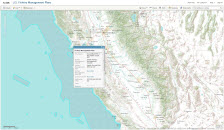Fisheries Management
Fisheries management involves regulating when,
where, how, and how much fishermen are allowed to harvest to ensure
sustainability. The Oceans community gallery  contains information about
U.S. Fishery Management Plans (FMPs) with information including the
plan's name and links to the federal regulations that apply within
each plan area.
contains information about
U.S. Fishery Management Plans (FMPs) with information including the
plan's name and links to the federal regulations that apply within
each plan area.
Fisheries management includes regulating when, where, how, and how much fishermen are allowed to harvest to ensure that there will be fish in the future. NOAA Fisheries Service is the Federal agency responsible for fisheries management in the United States' "Exclusive Economic Zone" (EEZ), waters. Coastal states are responsible for inshore waters out to 3 miles of the coast. The 30 coastal states often manage their fisheries through interstate marine fisheries commissions and/or through state-specific management programs. NOAA Fisheries Service plays a supportive and advisory role in the management of living marine resources in coastal areas under state jurisdiction, and the states generally operate in partnership with NOAA to ensure that management is consistent, conservative, and science-based.
Aquaculture farming and the challenge of maintaining seafood as a sustainable food source are increasingly important to the Fisheries industry. Every coastal state in the U.S. is engaged in some form of aquaculture. Yet, it accounts for a small portion of our fisheries. The estimated value of US aquaculture production is $1 billion while the overall world aquaculture production is $100 billion (with Asia accounting for almost 90%). Managing these resources in our coastal waters will become increasingly important as a food source as will the requirement to properly plan locations for aquaculture farming.
